Quick Look
Grade Level: 9 (9-11)
Time Required: 3 hours 15 minutes
(Conduct as an in-depth, three- to four-class period design project.)
Expendable Cost/Group: US $3.00
Group Size: 3
Activity Dependency: None
Subject Areas: Earth and Space, Physical Science, Physics, Science and Technology
NGSS Performance Expectations:

| HS-PS3-3 |
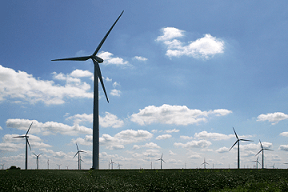
Summary
Students learn how engineers harness the energy of the wind to produce power by following the engineering design process as they prototype two types of wind turbines and test to see which works best. Students also learn how engineers decide where to place wind turbines, and the advantages and disadvantages to using wind power compared to other non-renewable energy sources.Engineering Connection
Engineers are responsible for developing, designing, testing and improving ways in which electricity is generated for our homes and businesses. One way to generate power is to harness the energy of the wind using a wind turbine. Engineers are responsible for the design, implementation and testing of wind turbines all over the world. Civil, mechanical and electrical engineers work together to determine the most ideal locations for wind farms and the most efficient turbine designs for specific conditions.
Learning Objectives
After this activity, students should be able to:
- Describe how wind turbines transfer the energy of the wind into electricity.
- Compare and contrast two different types of wind turbines.
- List several advantages and disadvantages for using wind power.
- Use the engineering design process to create prototype wind turbines.
Educational Standards
Each TeachEngineering lesson or activity is correlated to one or more K-12 science,
technology, engineering or math (STEM) educational standards.
All 100,000+ K-12 STEM standards covered in TeachEngineering are collected, maintained and packaged by the Achievement Standards Network (ASN),
a project of D2L (www.achievementstandards.org).
In the ASN, standards are hierarchically structured: first by source; e.g., by state; within source by type; e.g., science or mathematics;
within type by subtype, then by grade, etc.
Each TeachEngineering lesson or activity is correlated to one or more K-12 science, technology, engineering or math (STEM) educational standards.
All 100,000+ K-12 STEM standards covered in TeachEngineering are collected, maintained and packaged by the Achievement Standards Network (ASN), a project of D2L (www.achievementstandards.org).
In the ASN, standards are hierarchically structured: first by source; e.g., by state; within source by type; e.g., science or mathematics; within type by subtype, then by grade, etc.
NGSS: Next Generation Science Standards - Science
| NGSS Performance Expectation | ||
|---|---|---|
|
HS-PS3-3. Design, build, and refine a device that works within given constraints to convert one form of energy into another form of energy. (Grades 9 - 12) Do you agree with this alignment? |
||
| Click to view other curriculum aligned to this Performance Expectation | ||
| This activity focuses on the following Three Dimensional Learning aspects of NGSS: | ||
| Science & Engineering Practices | Disciplinary Core Ideas | Crosscutting Concepts |
| Design, evaluate, and/or refine a solution to a complex real-world problem, based on scientific knowledge, student-generated sources of evidence, prioritized criteria, and tradeoff considerations. Alignment agreement: | At the macroscopic scale, energy manifests itself in multiple ways, such as in motion, sound, light, and thermal energy. Alignment agreement: Although energy cannot be destroyed, it can be converted to less useful forms—for example, to thermal energy in the surrounding environment.Alignment agreement: Criteria and constraints also include satisfying any requirements set by society, such as taking issues of risk mitigation into account, and they should be quantified to the extent possible and stated in such a way that one can tell if a given design meets them.Alignment agreement: | Energy cannot be created or destroyed—it only moves between one place and another place, between objects and/or fields, or between systems. Alignment agreement: Modern civilization depends on major technological systems. Engineers continuously modify these technological systems by applying scientific knowledge and engineering design practices to increase benefits while decreasing costs and risks.Alignment agreement: |
Common Core State Standards - Math
-
Reason abstractly and quantitatively.
(Grades
K -
12)
More Details
Do you agree with this alignment?
-
Solve linear equations and inequalities in one variable, including equations with coefficients represented by letters.
(Grades
9 -
12)
More Details
Do you agree with this alignment?
-
Use units as a way to understand problems and to guide the solution of multi-step problems; choose and interpret units consistently in formulas; choose and interpret the scale and the origin in graphs and data displays.
(Grades
9 -
12)
More Details
Do you agree with this alignment?
-
Reason quantitatively and use units to solve problems.
(Grades
9 -
12)
More Details
Do you agree with this alignment?
International Technology and Engineering Educators Association - Technology
-
Students will develop an understanding of the attributes of design.
(Grades
K -
12)
More Details
Do you agree with this alignment?
-
Students will develop an understanding of engineering design.
(Grades
K -
12)
More Details
Do you agree with this alignment?
-
Students will develop abilities to apply the design process.
(Grades
K -
12)
More Details
Do you agree with this alignment?
-
A prototype is a working model used to test a design concept by making actual observations and necessary adjustments.
(Grades
9 -
12)
More Details
Do you agree with this alignment?
-
Energy resources can be renewable or nonrenewable.
(Grades
9 -
12)
More Details
Do you agree with this alignment?
State Standards
Colorado - Math
-
Solve linear equations and inequalities in one variable, including equations with coefficients represented by letters.
(Grades
9 -
12)
More Details
Do you agree with this alignment?
-
Use units as a way to understand problems and to guide the solution of multi-step problems.
(Grades
9 -
12)
More Details
Do you agree with this alignment?
-
Reason quantitatively and use units to solve problems.
(Grades
9 -
12)
More Details
Do you agree with this alignment?
Colorado - Science
-
Develop, communicate, and justify an evidence-based scientific explanation regarding the potential and kinetic nature of mechanical energy
(Grades
9 -
12)
More Details
Do you agree with this alignment?
-
Use appropriate measurements, equations and graphs to gather, analyze, and interpret data on the quantity of energy in a system or an object
(Grades
9 -
12)
More Details
Do you agree with this alignment?
Materials List
Each group needs:
- a 2-4 inch (5-10 cm) long block of cylindrical wood, at least 3/4 inch (1.9 cm) in diameter, for the horizontal-axis turbine
- a 6-8 inch (15-20 cm) long block of cylindrical wood, at least 3/4 inch (1.9 cm) in diameter, for the vertical-axis turbine
- Wind Turbine Worksheet
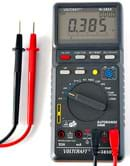
For the entire class to share:
- 1-2 multimeters or voltmeters
- 2 double-ended alligator clip wire test leads
- 1-2 DC motors (available at RadioShack [suggested part numbers: 273-223, 273-047, or 273-106] or hobby stores; make sure the shaft does not have a gear on it.)
- drill
- drill bit equal to the diameter shaft of the hobby motor
- 2 blocks of 2 x 4 wood, each about 5 inches (12.7 cm) long
- two 2.5-inch (6.35 cm) nails or screws
- hammer or screwdriver
- one 3-5-inch (7.6-12.7 cm) piece of PVC pipe with an interior diameter that is slightly larger than the diameter of the blocks of cylindrical wood used for turbine construction
- various materials from which to construct turbine blades, such as foam core board, index cards, plastic bottles, cardboard, particle board, thick poster board, foam board, thin dowel rods, bamboo skewers, etc.
- scissors
- glue
- strong tape, such as duct tape or packing tape
- a house or box fan with three-speed settings
Worksheets and Attachments
Visit [www.teachengineering.org/activities/view/cub_housing_lesson04_activity2] to print or download.Pre-Req Knowledge
A basic understanding of the concepts of kinetic and potential energy, work and power. To complete the worksheet, ability to solve basic algebraic equations.
Introduction/Motivation

- How many of you have ever seen a wind turbine spinning in the wind? Perhaps you noticed many wind turbines along a highway in big open fields. Does anyone know who designs, builds and decides the best locations to place wind turbines? Engineers are responsible for the design of wind turbines and where to place them to best generate electricity from the energy in the wind. Engineers create wind farms—large groupings of wind generators—at locations that have strong and dependable winds.
- Wind is a natural renewable energy source that exists because of the sun. Where sunlight reaches the Earth, the air absorbs some of that heat. At a certain point that air becomes hot enough that it rises (because hot air is lighter than an equal volume of colder air). When this hot air rises, cold air rushes in to take its place. This movement is what we feel as wind. Can anyone tell me what type of energy we find in the wind? Energy in the form of kinetic energy comes from the motion of the wind. It might not seem like wind has a lot of energy since the mass of air is so small; however, quite a lot of energy exists when the wind is blowing fast. By spacing out many turbines in one area of high wind velocity, engineers are able to harness the energy contained in all that moving air.
- When this moving air (or wind) contacts something like a windmill (one way to use the wind to generate energy) or the blades of a wind turbine, it transfers some of its energy into spinning the blades. The blades then turn the shaft of the turbine that is connected to a generator that converts the mechanical energy of the spinning shaft into electrical energy that we use in our houses. So a wind turbine is an example of conservation of energy and energy transfer. A wind turbine takes in the kinetic energy of the wind, transfers it to rotational energy of the rotor blades and shaft, which a generator converts into electrical energy.
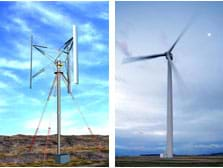
A vertical-axis wind turbine (left) and a horizontal-axis wind turbine (right). - Commercial wind turbine design can be a specialized process. Most modern wind turbines are designed to get the most out of the wind and thus engineers use principles of aerodynamics, such as lift and drag, to best design a turbine blade. These are the same principles that enable airplanes to stay in the air and fly. The resulting blades are called airfoils for the way they take advantage of lift and drag. The power output of wind turbines is directly related to the diameter of the blades. The wider the blades, the higher the power output; this makes sense if you imagine how with bigger blades more air hits the blades and causes them to spin. Wind turbines are generally located in places with consistent wind, because if the wind is not blowing, the turbines are not generating electricity. They are also designed to be extremely tall because, in general, wind speeds are greater the higher up you go. For this reason wind turbines are often located on the tops of hills and reach heights into the hundreds of feet.
- Two different kinds of wind turbines are commonly used to harness wind energy — vertical-axis wind turbines (VAWT) and horizontal-axis wind turbines (HAWT). The difference between the two types is the location of the shaft of the turbine. In a VAWT the shaft is oriented vertically whereas in a HAWT the shaft is oriented horizontally. Each type of wind turbine has its flaws and advantages.
- Wind is a terrific renewable energy source because as long as the sun is shining, there will be wind, and as long as there is wind, there is energy. Today we are going to learn more about both types of wind turbines by building one example of each type and then testing each design to see how they perform. Throughout this process we will follow the same steps that engineers follow in the engineering design process (EDP); ask: identify the need and constraints; research the problem; imagine: develop possible solutions; plan: select a promising solution; create: build a prototype; test and evaluate prototype; improve: redesign as needed to make a final decision about which type of windmill we would recommend be built.
Procedure
Background
Vertical-Axis Wind Turbines (VAWTs) are very rare to find today. The most prevalent of this type of VAWT is the Darrieus turbine, which looks somewhat like an egg beater. To be a VAWT, the chief characteristic is that the blades spin a shaft that is aligned vertically (perpendicular) to the ground. Any turbine designed like this is a VAWT.
Two main disadvantages of VAWTs make HAWTs the more common design used today. One disadvantage is that commercial VAWTs cannot start spinning on their own; they require a little boost from an electrical system. Another disadvantage is that instead of being supported with a tower like HAWTs, VAWTs are held up with wires, which limits the height that they can reach, and thus limits the winds they can access (lower elevations means slower wind speeds). For these two reasons, commercial VAWTs are less efficient than HAWTs.
One advantage of using a VAWT over a HAWT is that the VAWT is always aligned with the wind. This means that even if the wind direction changes, the blades still rotate. (HAWTs must have additional equipment to align their blades with the wind direction.) Another VAWT characteristic is that all of the turbine equipment (the generator, gearbox, etc.) is located on the ground, which makes maintenance easier, but also takes up more ground space, which can be a disadvantage in certain locations.
Horizontal-Axis Wind Turbines (HAWTs) are often used for large-scale, utility electrical production using wind energy. HAWTs are more recognizable and better known than VAWTs. The optimal wind speed for these turbines is about 15 m/s. At this speed, most large turbines are able to produce their maximum power output. At about 20 m/s, most turbines shut down because of the danger to the structure due to wind speeds that high.
Several advantages suggest using a HAWT instead of a VAWT. First, HAWTs are more efficient than VAWTs, which means they generate more electricity if placed in the same spot as a VAWT. Another advantage is that they can reach much higher elevations because they use a tower to lift the turbine higher into the air where wind speeds are greater. They also generally have a smaller footprint (take up very little ground area), which is an important consideration in certain places.
HAWT disadvantages include the fact that all the turbine components are located hundreds of feet above the ground, making maintenance more difficult. HAWTs also must be adjusted to the direction of the wind; this requires designing a system that tracks the wind and automatically moves the blades into optimum position to catch the most wind.
Before the Activity
- A few days before the activity, have students gather and bring from home a variety of plastic bottles, cardboard and other materials from which turbine blades can be made.
- Gather materials and make copies of the Wind Turbine Worksheet, one per group.
- Drill a hole on one end of each cylindrical block of wood equal in diameter to the diameter of the shaft of the hobby motor. Place the hole as close to the exact center of the wood as possible.
- Assemble the turbine testing device(s) using the wooden blocks, nails or screws, PVC pipe, DC motor, duct tape and alligator clip wires, as shown below.
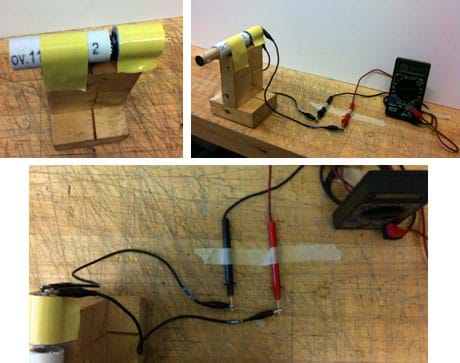
Assemble the class turbine testing device. Nail or screw together the two wooden blocks. Tape the PVC pipe and motor on top of the wooden block base. Connect the motor to a multimeter. - In this activity, each group creates a turbine on their own cylindrical blocks of wood and then takes turns placing their turbines on the class turbine testing device(s) to measure voltage.
With the Students
- Divide the class into groups of two or three students each.
- Distribute the worksheets and blocks of wood.
- EDP Steps 1 and 2: ask to identify need and constraints, and research the problem: Through a class discussion, generate the problem that the students are trying to solve by designing wind turbines; this should include how to generate electricity for a house using a renewable energy source. Discuss design constraints with the students (i.e., students can only use the materials provided, time constraint).
- EDP Step 3: imagine possible solutions. In groups, have students brainstorm designs for a vertical-axis turbine and a horizontal-axis turbine Possible questions to ask: How many blades? How to space them? From what material should we make the blades? What shape for the blades? Have students record all their brainstorm ideas on their worksheets.
- EDP Step 4: plan by selecting a promising solution. From a review of their brainstorming exercise results, have each group choose one vertical and one horizontal design to build for their wind turbine models. Direct them to draw their designs on their worksheets and explain why they chose those designs.
- EDP Step 5: create a prototype. Next, have each group build their turbines. Use the shorter cylindrical wood blocks for the horizontal-axis wind turbine. Use the longer cylindrical wood blocks for the vertical-axis turbine. Attach the turbine blades onto the side of the wood opposite the side with the hole drilled into it.
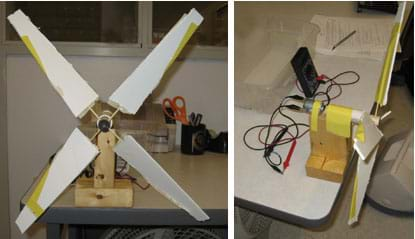
Front and side view of activity setup with a hobby motor and multimeter connected to one team's block of wood and prototype wind turbine. - EDP Step 6: test and evaluate prototype. Once a group has finished building their designs, have them test them. To do this, have them stick the end of the model turbine through the PVC pipe on the testing device and onto the shaft of the motor. You may want to tape the front end of the testing device to the surface it is sitting on in order to prevent movement during testing. Once the turbine is connected, have one student operate the fan at each speed setting.
- Have each group take turns testing their turbine designs at three different fan speeds, recording the output data on their worksheets.
- Repeat the testing procedure for the other turbines, again recording the data on their worksheets.
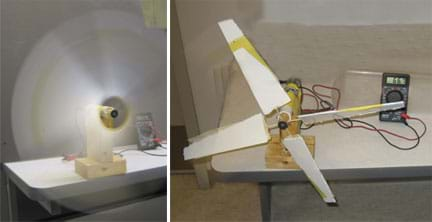
A student team's prototype wind turbine design being tested and measured. - Have students complete the calculations and analysis on their worksheets.
- EDP Step 7: improve and redesign as needed. Conclude with a class discussion to review and compare the groups' findings. What improvements would they make? Where would they locate turbines near their energy-efficient houses? See additional post-activity discussion questions in the Assessment section.
- Have student teams present their designs to the rest of the class, as described in the Assessment section.
Vocabulary/Definitions
conservation of energy: Physical law stating that the energy of a system must stay constant and energy cannot be created.
energy: The ability of an object to do work.
energy transfer: The process through which energy is converted from one form to another.
generator: A device that converts mechanical energy into electrical energy.
horizontal-axis wind turbine: Wind turbine with the shaft oriented horizontally.
kinetic energy: An object's energy due to its motion.
non-renewable energy source: An energy source that is not replenished in a short period of time.
renewable energy: Energy that is derived from a renewable source.
renewable energy source: An energy source that is replenished naturally in a short period of time.
vertical-axis wind turbine: Wind turbine with the shaft oriented vertically.
voltmeter: An instrument that measures voltage.
wind energy: Energy that is generated using the wind.
wind turbine: A mechanical device that generates electricity from the wind.
work: The mechanical transfer of energy from one object to another.
Assessment
Pre-Activity Assessment
Class Discussion: As a class, discuss the following:
- Does anyone know what a windmill can be used for, or why people in the past built windmills? (Possible answers: For grinding corn, grain and other crops, for pumping water.)
- How are windmills able to do what they were built for? (Answer: They transfer the kinetic energy of the wind into rotational energy to be able to grind or pump.)
- In what other ways have people in the past used the wind for energy or power? (Possible answer: To move a boat by using a sail; the wind pushes against the boat's sails and transfers its energy into moving the boat.)
Activity Embedded Assessment
Worksheet: Have students complete the activity worksheet; review their answers to gauge their mastery of the subject.
Post-Activity Assessment
Class Discussion: As a class, discuss the following:
- What parts of your designs seemed to result in greater efficiencies of converting the kinetic energy of the wind into electrical energy?
- In what ways could improvements be made to increase the efficiency of your turbines?
- What effect would incorporating aerodynamics into your designs have on the performance of your turbines?
Class Presentation: Have student groups present their designs to the rest of the class. Require them to include descriptions of how well the wind turbines worked, which type of turbine worked best, and what improvements they might make to their designs.
Troubleshooting Tips
Some motors have easy-to-spot connectors (two pieces of metal sticking out of the motor with a hole in the middle) that make attaching wires and multimeters/voltmeters to the motor leads straightforward, while others do not. If using a motor in which the connectors are absent on the motor, look for (at least) two slits for connectors on opposite sides of the motor. Have students place the leads of the wires or multimeters in two of these slits. If more than two slits, have students place the leads in one pair of the slits and turn the shaft of the motor manually. If the multimeter/voltmeter reads a voltage or current when the shaft spins, then these are the connectors. If it does not, then the other pair of slits is the connector. Have students check the motor for a voltage and current reading on the multimeter/voltmeter.
One easy way to measure voltage from the motor is to attach electrical wire to the motor connectors and use alligator clips on the ends of the multimeter/voltmeter leads. You can create one or more testing stations this way, and the students can just attach their wind turbines to the set-up.
Activity Extensions
Have students research the role of aerodynamics on wind turbines. Assign them to write a paragraph or two on the effects of forces such as lift and drag on modern turbines.
Activity Scaling
- For younger students, eliminate the mathematical analysis from the worksheet.
- For older or more advanced students, have them write paragraphs detailing the materials and features of their turbine designs and why they designed them the way they did.
Additional Multimedia Support
Explore the potential for wind energy anywhere in the US at the Renewable Energy Living Lab, which provides access to a tremendous amount of real wind data collected throughout the US and probably for a town near you. See http://www.teachengineering.org/livinglabs/
Subscribe
Get the inside scoop on all things TeachEngineering such as new site features, curriculum updates, video releases, and more by signing up for our newsletter!More Curriculum Like This

Students learn about wind as a source of renewable energy and explore the advantages and disadvantages wind turbines and wind farms. They also learn about the effectiveness of wind turbines in varying weather conditions and how engineers work to create wind power that is cheaper, more reliable and s...

Students learn and discuss the advantages and disadvantages of renewable and non-renewable energy sources. They also learn about our nation's electric power grid and what it means for a residential home to be "off the grid."

Hydropower generation is introduced to students as a common purpose and benefit of constructing dams. Through an introduction to kinetic and potential energy, students come to understand how a dam creates electricity.

Students get introduced to the real-world technical tool of a wind turbine propeller attachment. It’s a device that efficiently harvests wind energy, and in this activity they’ll build one of their own using a LEGO wind turbine, fan, and energy meter.
References
Layton, Julia. How Wind Power Works. Posted August 9, 2006. HowStuffWorks.com. Accessed March 31, 2009. http://science.howstuffworks.com/wind-power.htm
Copyright
© 2007 by Regents of the University of ColoradoContributors
Tyler Maline; Lauren Cooper; Malinda Schaefer Zarske; Denise W. CarlsonSupporting Program
Integrated Teaching and Learning Program, College of Engineering, University of Colorado BoulderAcknowledgements
The contents of this digital library curriculum were developed under grant from the Fund for the Improvement of Postsecondary Education (FIPSE), U.S. Department of Education and National Science Foundation (GK-12 grant no. 0338326). However, these contents do not necessarily represent the policies of the DOE or NSF, and you should not assume endorsement by the federal government.
Last modified: August 30, 2020










User Comments & Tips